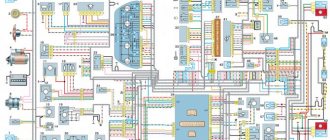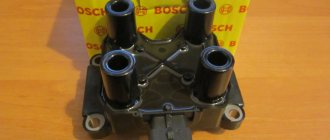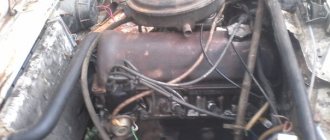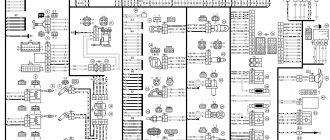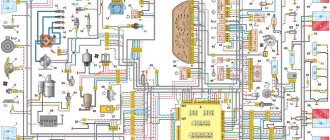Removal
1. We prepare the car for operations (see “Preparing the car for maintenance and repair”).
2. Disconnect the wire from the negative terminal of the battery (see “Battery - removal and installation”).
3. Remove the upper steering shaft casing (see “Steering shaft casings - removal and installation”).
5. Using a Phillips screwdriver, unscrew the self-tapping screw of the front fastening of the storage shelf.
6. Using the same tool, unscrew the self-tapping screw securing the shelf on the left side.
7. Unscrew the two self-tapping screws securing the shelf on the right side.
9. Using the same tool, unscrew one screw at the bottom fastening of the radio panel on the left and right sides.
10. Unscrew the two screws of the upper panel fastening.
11. Remove the radio panel.
12. Having opened the cover, use a Phillips screwdriver to unscrew the two self-tapping screws securing the glove box body.
13. Remove the glove box body from the instrument panel.
14. Using a short Phillips screwdriver, unscrew the three screws securing the instrument panel insert (the photo shows two screws).
15. Use a slotted screwdriver to pry up and remove the handles of the heater control levers.
16. Using the same tool, pry up the instrument panel trim and remove it.
17. Using a Phillips screwdriver, unscrew the two self-tapping screws securing the interior ventilation and heating control unit.
18. Disconnect wire block A from the glove compartment lamp and disconnect the “mass” wire B.
19. By pulling, remove the handle from the headlight hydraulic adjustment.
21 mm socket wrench
Unscrew the nut securing the hydraulic corrector and push it inside the instrument panel.
21. Disconnect the connectors of the instrument lighting control wires.
22. Having marked the wires, disconnect them from the cigarette lighter.
23. Using a Phillips screwdriver, unscrew the four self-tapping screws of the lower fastening of the instrument panel to the body (the photo shows the self-tapping screw of the lower right fastening).
10 mm socket or socket wrench
Unscrew the two nuts on the upper fastening of the instrument panel.
25. Using the same tool, through the hole for installing the glove box body, unscrew two more nuts for the upper fastening of the instrument panel and remove it.
Model 2105 Instrument Panel - Removing and Replacing Bulbs
Location of lamps on the instrument panel: 1 — speedometer illumination lamp (AMH 12-3-1 (T3W); 2 — signaling unit (A 12-1.2 (W1.2W); 3 — battery charge indicator lamp (AMH 12- 3-1 (T3W); 4 — instrument cluster illumination lamp (AMH 12-3-1 (T3W); 5 — insufficient oil pressure warning lamp (AMH 12-3-1 (T3W); 6 — fuel reserve warning lamp (AMH 12-3-1 (T3W); 7 — voltmeter backlight lamp (AMH 12-3-1 (T3W); 8 — control lamp for turning on the external lighting (AMH 12-3-1 (T3W); 9 — control lamp for turning on the direction indicators (AMH 12-3-1 (T3W); 10 - high beam indicator lamp (AMH 12-3-1 (T3W)
1. We prepare the car for operations (see “Preparing the car for maintenance and repair”).
2. Disconnect the wire from the negative terminal of the battery (see “Battery - removal and installation”).
3. Using a thin screwdriver, remove the two plugs for the screws securing the shield.
4. Using a Phillips screwdriver, unscrew the two screws.
5. Disconnect the wires from the fan switch terminals. The top wire is blue-black, the middle wire is yellow-blue, and the bottom wire is red.
To avoid injury from the protruding plugs of the switch when disconnecting the speedometer drive cable, we recommend removing the switch by squeezing its latches.
6. Moving the instrument panel as far as possible to the left, unscrew the knurled nut securing the speedometer cable by hand and disconnect the cable.
7. Disconnect the three colored connectors of the instrument panel wiring harness (red, green and white) from the instrument panel wiring harness.
8. Moving to the right, remove the instrument panel.
1. Remove the lamp socket from the housing.
2. By pressing and turning counterclockwise, remove the lamp from the socket and install a new one.
Replacing the backlight lamps of the speedometer and voltmeter instrument cluster
1. Using a screwdriver, remove the lamp socket from the lamp body.
Malfunction of the electronic engine control unit (ECU, ECM, controller)
An electronic engine control unit, abbreviated as ECU, ECM, controller, is an electronic device that, using various signals from engine sensors, controls the composition and amount of fuel supplied to the engine. Having a built-in diagnostic system, it can recognize problems in the system, warning the driver about them through a warning lamp (Check engine). It also stores diagnostic codes that indicate areas of trouble to help technicians make repairs.
Symptoms of a malfunction of the electronic engine control unit:
— Lack of control signals for injectors, ignition, fuel pump, valve or idle mechanism, and other actuators. - No response to Lambda - regulation, temperature sensor, throttle position sensor, etc. - No communication with the diagnostic tool. — Physical damage (burnt radio elements, conductors).
You can purchase an electronic engine control unit (ECU, ECM, controller) from us!
DON'T STROKE - BUY CHEAPER! ! !
Causes of malfunction of the electronic engine control unit:
1. Unqualified intervention in the car’s electrical system when installing alarms and carrying out repairs. 2. “Lighting up” from a car with the engine running. 3. “Reversal of polarity” when connecting the battery. 4. Removing the battery terminal with the engine running. 5. Turning on the starter with the power bus disconnected; 6. Contact of the electrode during welding work with the sensors or wiring of the vehicle. 7. Water entering the ECM. 8. Broken or shorted wiring. 9. Malfunction of the high-voltage part of the ignition system: coils, wires, distributor
ECU diagnostics involves reading errors recorded in the controller’s memory. Reading is performed using special equipment: PC, cable, etc. via diagnostic K-line. You can also get by with an on-board computer that has the function of reading ECM errors.
The ECU stores diagnostic codes that indicate areas of trouble to assist technicians in making repairs.
If the ECM fails due to a problem in the wiring or actuator, a simple replacement may not give anything other than two, three, etc. burnt blocks.
To find out which controller is on your car, you will have to remove the side frame of the car's instrument panel console. Remember the number of your ECU and find it among the tables presented.
You can purchase an electronic engine control unit (ECU, ECM, controller) from us!
DON'T STROKE - BUY CHEAPER! ! !
The information will also be useful to you: Varieties of electronic engine control systems (ECM, controllers), which are installed on different models of the VAZ family car.
If you haven't found the answer you are looking for, then ask your question! We will respond shortly.
Don’t forget to share the information you find with your friends and acquaintances, as they may also need it - just click one of the social networking buttons.
Removing the instrument panel VAZ-2105
Instrument panel and its accessories
1 – lining of heater control levers; 2 – instrument panel; 3 – instrument panel; 4 – insert; 5 – ashtray; 6 – side shield; 7 – glove box body; 8 – shelf; 9 – glove box cover; 10 – hinge of the glove box lid; 11 – radio mounting panel
Instrument panel mounting points
Removal ORDER 1. To remove the instrument panel (see Fig. Instrument panel and its accessories), perform the following operations: disconnect the ground wire from the battery. 2. Unscrew the fastening screws and remove the steering shaft facing casing. 3. Taking out two plugs and unscrewing the fastening screws, remove the 2 instrument panel. 4. Disconnect the connectors and wire plugs from the devices. 5. If you have a headlight hydraulic corrector, remove the handle from it, unscrew the fastening nut and remove it from the instrument panel. 6. Unscrew the fastening screws and remove shelf 8. 7. Remove the side panel and body of the glove box. 8. Remove the handles from the heater control levers, to do this, at the junction of the handle and the lever, bend the lower part of the upper and middle handles with a thin sharp tool, and the upper part of the lower one. 9. Remove the trim 1 of the heater control levers. 10. Unscrew the fastening screws and remove panel 11 of the radio receiver. 11. Remove the four screws of the lower fastening (see Fig. Mounting points of the instrument panel) of the panel to the front cross member. 12.Through the openings of the instrument panel and glove box, unscrew the four nuts of the upper fastening of the instrument panel. 13. Disconnect insert 4 (see Fig. Instrument panel and its accessories) by removing the fastening screws. 14. Unscrew the three fastening nuts and remove the loudspeaker if it is installed on the car. 15. Remove panel 3 and disconnect the wires from the cigarette lighter. Installation
Installing the instrument panel is performed in reverse order.
Source
Description of the torpedo on the VAZ 2105
The front panel is a metal frame covered with polyurethane foam and a special film, mounted in the front part of the cabin. The product contains an instrument cluster, radio panel, glove box and shelf, air ducts, levers and switches.
Torpedo VAZ 2105: 1 — windshield wiper and washer switch lever; 2 — sound signal switch; 3 — turn signal switch lever; 4 — headlight switch lever; 5 — side nozzles of the interior ventilation and heating system; 6 — instrument lighting switch; 7 — engine hood lock drive lever;8 - headlight hydraulic adjustment;9 - ignition switch;10 - clutch pedal;11 - portable lamp connection socket;12 - brake pedal;13 - hazard warning switch;14 - accelerator pedal;15 - choke control handle carburetor; 16 — gear shift lever; 17 — parking brake lever; 18 — cigarette lighter; 19 — decorative cover for the radio socket; 20 — ashtray; 21 — storage shelf; 22 — glove box; 23 — block of control levers for the interior ventilation and heating system; 24 — plug; 25 — instrument panel
What kind of front panel can be installed instead of the standard one?
The torpedo of the VAZ “five” today does not look very beautiful: angular shapes, minimal instrumentation, black and not very high-quality finishing material, which cracks and warps over time. For this reason, many owners seek to improve the interior and functionality of their car by installing panels from other cars. On the VAZ 2105, with some modifications, you can install a torpedo from the following cars:
- VAZ 2105–07;
- VAZ 2108–09;
- VAZ 2110;
- BMW 325;
- Ford Sierra;
- Opel Kadett E;
- Opel Vectra A.
Dashboard
The dashboard of the VAZ Five, as in any other car, is an integral part, since it contains devices for monitoring the technical condition of the car while driving. The device is installed on the left side of the dashboard opposite the steering wheel, which makes it easy to read information. The device is equipped with the following elements:
Instrument panel of VAZ 2105: 1 — external lighting switch; 2 — warning lamp for insufficient oil pressure in the engine lubrication system; 3 — fluid temperature indicator in the engine cooling system; 4 — battery charge warning lamp; 5 — warning lamp block; 6 — speedometer ;7 - totalizing trip meter;8 - rear window heating switch;9 - plugs for the instrument panel mounting screws;10 - three-position switch for the electric heater fan;11 - indicator lamp for turning on the high beam;12 - indicator lamp for turning on the direction indicators;13 - indicator lamp turn on side lights;14 - voltmeter;15 - instrument cluster;16 - fuel level indicator;17 - fuel reserve warning lamp;18 - rear fog light switch
The instrument panel uses the following devices:
- speedometer;
- signal light block;
- car odometer;
- voltmeter;
- coolant temperature sensor;
- fuel level sensor in the tank.
What kind of dashboard can be installed
The “five” dashboard can be improved in several ways:
- perform tuning using new lighting elements, scales and instrument needles;
- introduce an instrument cluster from another car;
- do the tidy yourself by installing the necessary indicators.
It is possible to modify the shield by replacement, but only with careful selection and adjustment of the device to the standard torpedo, as well as after preliminary development of the connection diagram.
From another VAZ model
Some owners install a panel from Kalina on the fifth model of Zhiguli. The product looks modern, and the information from the instruments is much better readable. The essence of the modification comes down to installing a new shield into the standard case, for which it needs to be filed, trimmed, and assembled with the new mechanism. After completing the mechanical work, it is necessary to connect the new instrument panel with the wiring, checking the functionality of all gauges and indicators.
On the VAZ 2105 you can install an instrument cluster from Kalina
From "Gazelle"
If you like the instrument cluster from the Gazelle, then you can install it. At the same time, you need to understand that you will have to redo the wiring by making adapters due to mismatched connectors, and then install the product in a standard case with the accompanying stages of adjustment and modification.
Diagnostics using third-party devices
For a more detailed check of the vehicle's performance, scanners and computers are used. They are connected to the diagnostic electrical connector (socket) located on the standard panel. Malfunctions are issued in the form of a standard set of alphanumeric codes, consisting of one letter and four numeric designations. The letter indicates specific nodes in which the malfunction occurred.
B - detects problems with electronics inside the cabin;
C - indicates defects in the chassis design;
P - errors in the engine control module or transmission;
U - loss of communication between electronic modules.
The letter designation is followed by four characters:
- the first character indicates a standard code established by engineers at the Automobile Association;
- the second character records personal codes set by manufacturers;
- the third character indicates which system the malfunction occurred in:
1-2 - in the fuel and air system;
- in the ignition system;
- in a secondary emission control system;
- in the speed control controls or when the load is off (XX);
- on-board computer system and wiring;
7-8 - errors in the operation of the gearbox;
9.0 - reserve;
the fourth and fifth symbols are considered together to more accurately locate the point of failure.
Possible faults
Dismantling and repair of the device may be required for the following malfunctions:
- The control panel backlight does not light up. You should check the condition of the wiring, contacts, and the serviceability of fuses.
- Not a single sensor or indicator works, and the warning lights do not light up. First of all, you should check the fuse in the mounting block and replace it if it is burned out.
- If the indicator arrows jerk in different directions, the cause is most often poor ground contact.
- Malfunctions may be related to the operation of the dashboard itself. It is necessary to dismantle the shield and carry out diagnostics.
- Sometimes the functionality of the device is caused by a malfunction of the cigarette lighter. The instrument panel does not work or does not function correctly.
- The functionality of the control panel sometimes disappears after tuning.
Tuning with LED lighting
EUR lada kalina: malfunctions and solutions, electric power steering does not work, reasons
Electric power steering is a component used to provide more comfortable driving. Not so long ago, domestically produced cars began to be equipped with EUR, in particular, in this article we will talk about Lada Kalinas. What malfunctions can occur with the Kalina EUR and what troubleshooting methods are there? Find answers to these and other questions below.
Why does the electric power steering on the Lada Kalina not work, turns off and refuses to work, what are the signs of a steering wheel with power steering knocking, jamming, biting or squeaking? To repair the system yourself, you need to know how diagnostics are carried out and what causes precede the breakdown. Most often, the failure of the amplifier is caused by a breakdown of the unit itself and the amplifier fails. Problems of this type are resolved by thoroughly checking the system to identify the exact problem.
As practice shows, often the inoperability of the electric amplifier (failure) is associated with a breakdown of the speed controller.
Consequences:
- the steering wheel is jammed,
- jams
- becomes tight
- and others
Because the speed controller sensor ensures activation and deactivation of the electric power steering under different driving modes. The amplifier on Kalina works if the car is moving at low speed. When the speed begins to increase, the booster automatically turns off, allowing for safer machine control when driving at high speeds.
So, briefly about the reasons for the inoperability of the EUR:
- The speed controller has failed or the control unit does not receive or disappears a signal from it. In this case, the reason may lie in either a breakdown of the sensor, damaged wiring, or poor contact of the controller with the on-board network.
- The voltage in the vehicle's electrical network has decreased. The reasons can be different, ranging from a dead battery and an inoperative generator to the use of inappropriate electrical equipment in the car.
- The permissible crankshaft speed has been exceeded.
- Incorrect operation or failure of the control module. Depending on the cause, the control unit may need to be repaired; more detailed diagnostics need to be done.
Diagnostics
To check the amplifier in a car, you need to remove the plastic trim on the steering column; to do this, unscrew the bolts securing it from the bottom.
Then you will need to get to the 8-pin plug, its pinout is as follows:
- The blue contact is connected to the ignition switch, this is 12 volt power;
- the red-brown contact is the connection cable to the tachometer;
- the gray contact goes to the car speed controller;
- white and pink wire - amplifier control indicator;
- black-yellow contact is a diagnostic line;
- the next contact is empty, the wire is not connected to it;
- brown contact is ground;
- empty.
More accurate results will be obtained by checking the amplifier using a scanner. But since such equipment can usually only be found at service stations, you can try to check the operation of the system with a paper clip.
To check you need to do the following:
- First the ignition is turned off.
- Then, using a paper clip, you need to close contacts numbered 6 and 7 of this plug, while the plug itself does not need to be removed.
- Next, the ignition must be turned on.
- After completing these steps, the EUR failure indicator located in the dashboard will begin to blink; by the number of blinks, you can determine whether the system is broken (the author of the video is Gosha Vakhromeev).
How to understand where to look for the cause by the blinking indicator icons:
- one long signal and one short signal - the electric amplifier is working;
- one long and two short - no engine speed signal;
- one long and three short - the torque controller is out of order or there is no power supply;
- one long and four short blinks—problems in the operation of the electric power steering motor;
- one long and five short - the steering shaft position controller has failed;
- one long and six short - the motor rotor position controller has failed;
- one long and seven short - problems with the electrical network - the voltage is either too high or very low;
- one long and eight short - the control module of the electric amplifier has failed;
- one long and nine short - the speed controller is broken.
Installation and repair instructions
Dismantling the control panel may be required for repairs, tuning the panel, replacing sensors, etc. The procedure is simple and can be performed at home.
Tools and materials
Tools for disassembly
To disassemble and repair the dashboard, you must prepare the following tools and materials:
- a set of keys;
- Screwdriver Set;
- diagnostic tester;
- new sensors and parts needed for replacement;
- elements for tuning.
It is better to buy originals to avoid fakes.
Algorithm of actions
To dismantle the tidy, you need to perform the following steps:
- Turn off the power supply to the machine by disconnecting the negative terminal from the battery.
- After unscrewing the mounting bolts, you need to remove the casing from the steering column.
- By removing the plugs and unscrewing two screws, the instrument panel is removed.
- Next, the wire plugs are disconnected.
- After opening the glove compartment, you need to unscrew the mounting bolts. The bolts securing the shelf for things are unscrewed in the same way.
- By pulling the handle of the hydraulic light corrector, you need to remove it. Then, using a socket wrench, unscrew the mounting nut and push it in.
- In the glove compartment, disconnect the power cord for the backlight lamp.
- After unscrewing the two bolts, you need to move the heater control unit.
- Next, you should dismantle the air duct.
- The next step is to unscrew all the console fasteners.
- When the last two fastening nuts in the center are unscrewed, you need to carefully remove the panel from the studs and remove it from the interior.
Next, the necessary repairs, tuning, replacement of sensors are performed, and backlighting is installed. After completing all the manipulations, the assembly of the device is carried out in the reverse order of disassembly.
To make assembly easier, during disassembly you should mark the wires and sort the devices and sensors.
Disconnecting connectors with wires
Possible reasons for dismantling the shield
In what cases is it necessary to remove the dashboard of a VAZ 2107 car? There may be several reasons for this:
- panel tuning;
- replacing burnt out light bulbs;
- repair of individual devices that have failed.
VAZ 2107 is a legendary car, which hundreds of thousands of car enthusiasts have repaired independently.
Tuning ideas
The VAZ 2105 was little modernized, mainly in the engine. Owners of “fives”, like UAZ cars, often resort to tuning the instrument panel to give it a modern look and increase functionality.
On the VAZ 2105, tuning is possible in the following options:
- purchase a ready-made kit, which includes dials for sensors, instrument panels, parts for lighting, wiring and terminals for connections;
- A budget option is to illuminate devices with LEDs of different colors;
- More technically difficult is the texture and color change of the console.
With the help of LED lighting, you can change the design of the control panel, make it stylish and give it a personal look.
What is included in the electrical circuit?
The VAZ electrical circuit consists of many components. We are talking about the generator, battery, optics, fuse blocks, warning lamps, as well as the instrument panel and other components. We are talking about both injector and carburetor engines. The system wires are marked in different colors, they correspond to those marked on the diagrams, this allows the car owner not to get confused during circuit diagnostics and repairs.
Complete wiring diagram for the domestic “five”
The wiring diagram of a VAZ 21053 carburetor or injector as a whole gives a complete picture of the circuit, without any specifics or explanations. Accordingly, the service manual for the vehicle should contain additional appendices explaining the purpose of electrical devices. In any case, one of the main components of the circuit is the ignition system. In general, there is nothing complicated about it, but during repairs it is easy to get confused in the wiring that goes from the relay to the fuse block and from to the block.
The wiring system also includes the electrical circuit for the instrument panel and engine start. Almost all equipment of the “five” is indicated by separate applications in the service manual, which greatly facilitates the repair and diagnostic procedure. For example, car owners often face the problem of direction indicators and fog lights not working correctly.
It is quite possible that devices refuse to function normally if the generator is not working correctly. Of course, if you have a diagram, it will be much easier to detect a malfunction. It should be noted that injection versions, unlike carburetor versions, are more complex due to the presence of additional sensors and regulators, injectors and other components.

